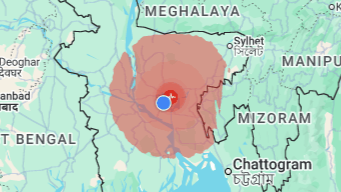Bangladesh Hit by 5.7 Magnitude Earthquake, Strong Tremors Felt in Dhaka

A powerful earthquake jolted Dhaka and several surrounding districts on Friday morning, causing panic among residents and prompting many to evacuate buildings. The tremor was felt at 10:38 (BST) and was strong enough to sway high-rise structures across the capital.
According to international seismic monitors, the earthquake measured between magnitude 5.5 and 5.7, with a shallow depth of around 10 km. The German Research Center for Geosciences (GFZ) reported a magnitude of 5.7, while other agencies placed it slightly lower.
The quake’s epicentre was recorded near areas east of Dhaka, and the impact was felt strongly throughout the capital. Residents reported sudden, sharp shaking that lasted several seconds. Many office workers, students, and residents rushed outdoors as buildings trembled.
Tremors were also reported across nearby regions, including parts of India such as Kolkata.
So far, no major casualties or large-scale damage have been officially confirmed, though minor cracks and structural concerns have been reported in a few buildings.
Safety and Alert Reminder
Authorities have advised citizens to remain cautious, as aftershocks are possible following a quake of this magnitude. Disaster response agencies and local emergency units are monitoring the situation closely.
Residents are urged to follow standard earthquake safety guidelines:
• Move to open spaces if shaking begins again.
• Stay away from windows, loose structures, and electrical hazards.
• Do not use elevators until structural safety is confirmed.
• Check for gas leaks, water line damage, and weakened walls.
• Follow updates from official sources and emergency authorities.
Dhaka is one of the world’s most densely populated cities and sits in a region with significant seismic activity. A shallow earthquake like today’s can produce strong surface-level shaking, especially affecting older buildings and structures not designed to withstand tremors.
Today’s incident serves as another reminder of the importance of strengthening disaster preparedness, improving building safety standards, and increasing public awareness about earthquake response.
At the time of reporting, Dhaka has returned to calm, with no widespread damage confirmed. Monitoring agencies continue to track seismic activity, and residents are encouraged to stay alert for official announcements.
Update (as of 17:30, 21 Nov 2025 BST):
At least six people have been confirmed killed after the quake. Authorities say dozens have been injured and damage assessments are ongoing.
Update (as of 23:45, 21 Nov 2025 BST):
The Disaster Management Directorate has confirmed 10 deaths across three districts following the earthquake. According to Nitai Chandra De Sarkar of the Monitoring and Information Management Subdivision, 5 deaths occurred in Narsingdi, 4 in Dhaka, and 1 in Narayanganj.
A total of 461 people have been reported injured nationwide, with Gazipur accounting for 252 injuries, the highest among all districts. Mr. Sarkar stated that officials are currently focused on assessing casualties and structural damage, noting that large-scale rescue operations have not yet been required.
Latest Articles
 Why Bangladesh Is Facing Frequent Earthquakes – Simple Explanation
Why Bangladesh Is Facing Frequent Earthquakes – Simple Explanation
 Test Twenty: A New Cricket Format Set to Launch in January 2026
Test Twenty: A New Cricket Format Set to Launch in January 2026
 The Future of the Internet Is Here: How Blockchain Might Put Power Back in Our Hands
The Future of the Internet Is Here: How Blockchain Might Put Power Back in Our Hands
 Windows 10 support ends Microsoft on October 14, 2025: The End of an Era
Windows 10 support ends Microsoft on October 14, 2025: The End of an Era
 The Teacher Who Chose Her Students Over Herself — Maherin Chowdhury
The Teacher Who Chose Her Students Over Herself — Maherin Chowdhury
Latest News
 Sheikh Hasina Sentenced to Death by Bangladesh Tribunal for 2024 Crackdown
Sheikh Hasina Sentenced to Death by Bangladesh Tribunal for 2024 Crackdown
 Israel and Hamas Reach First-Phase Ceasefire Deal, Hope Rises for End to Gaza War
Israel and Hamas Reach First-Phase Ceasefire Deal, Hope Rises for End to Gaza War
 England post record 304/2 to rout South Africa by 146 runs
England post record 304/2 to rout South Africa by 146 runs
 Taylor Swift Announces 12th Studio Album The Life of a Showgirl
Taylor Swift Announces 12th Studio Album The Life of a Showgirl
 Bangladesh Air Force Training Jet Crashes Near Milestone School in Uttara
Bangladesh Air Force Training Jet Crashes Near Milestone School in Uttara